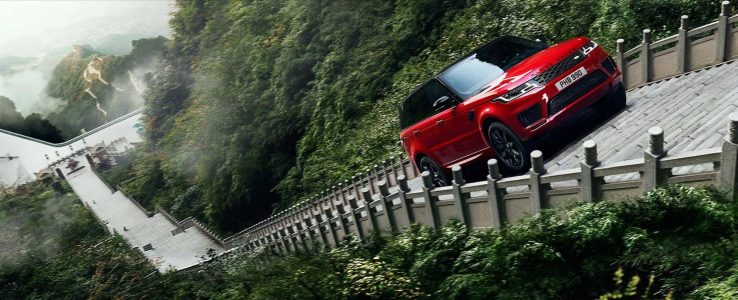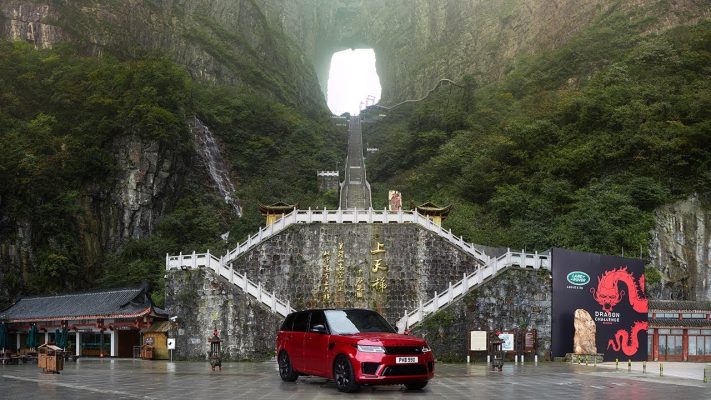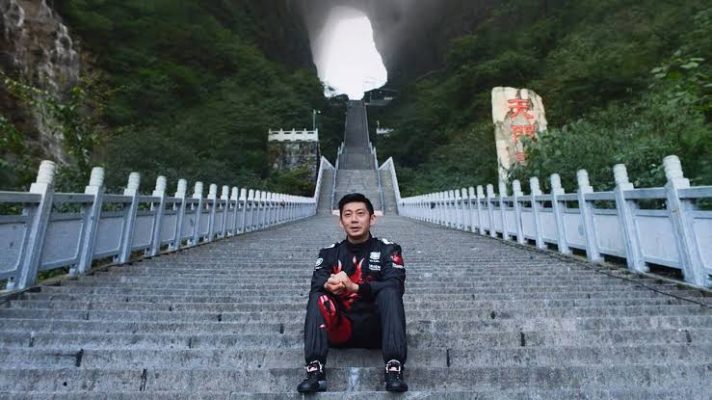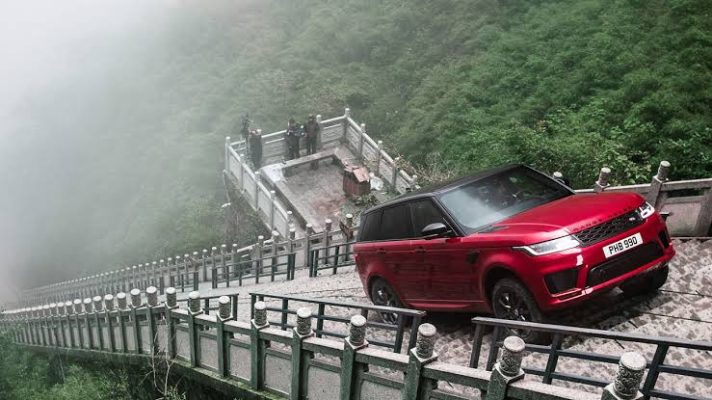 Pin
Pin Photo courtesy of rangerover.com
I’ve heard tell of plenty of foolish things done with automobiles in my time, but what happened on Tianmen Mountain in 2018 ranks among the most gloriously absurd. Some folks at Land Rover decided their Range Rover Sport Plug-In Hybrid ought to climb a staircase—and not just any flight of steps, mind you, but 999 of them, each one leading higher up a mountain face steeper than a church steeple’s roof. The Chinese call the destination “Heaven’s Gate,” which gives you some idea of the ambition involved.
The whole affair began with what they called the Dragon Challenge, a name that sounds like something a fellow might make up after too much rice wine. But the challenge was real enough. Professional racing driver Ho-Pin Tung would pilot this two-ton luxury vehicle up a twisting mountain road with 99 hairpin turns, then—and here’s where it gets interesting—drive straight up those 999 steps at a 45-degree angle. The entire spectacle took just under 22 minutes, which is about how long it takes most sensible people to realize they shouldn’t attempt such a thing in the first place.
Table of Contents
The Mountain That Touches the Sky
 Pin
Pin Photo courtesy of rangerover.com
Tianmen Mountain rises up from the Hunan Province like nature decided to build herself a monument. The locals have considered it sacred for centuries, and once you lay eyes on it, you understand why. The mountain shoots nearly 5,000 feet into the air, its cliffs dropping away so sharp they make your stomach do peculiar things just looking at photographs. Somewhere near the top sits a natural arch carved through solid rock by wind and rain over millions of years—that’s Heaven’s Gate, and it’s become something of a pilgrimage site for tourists who enjoy testing their nerve on glass walkways and cable cars that dangle over nothing but air and regret.
Getting to Heaven’s Gate requires navigating what the Chinese have dubbed “The Road to Heaven,” though “The Road to Second-Guessing Your Life Choices” might be more accurate. This serpentine pathway coils up the mountain through 99 switchback turns, each one tighter than the last. The road climbs over 3,600 feet in just seven miles, which gives you grades steep enough to make a mountain goat think twice. Then come those 999 steps, built centuries ago when people traveled by foot and apparently had more fortitude than modern folks. The steps rise at angles that would make a ladder manufacturer nervous, leading pilgrims and tourists alike up to that stone gateway in the sky.
A Vehicle Built for the Improbable
 Pin
Pin Photo courtesy of rangerover.com
The Range Rover Sport Plug-In Hybrid that took on this challenge wasn’t some stripped-down racing machine cobbled together in a workshop. It was a production vehicle, the same model you could walk into a dealership and drive home, though I suspect most dealers would prefer you didn’t immediately point it at a mountain staircase. Under the hood sat a hybrid powertrain combining a supercharged gasoline engine with an electric motor, producing a combined 398 horsepower. That’s considerable grunt, but horsepower alone won’t get you up a staircase—you need torque, that twisting force that actually moves weight, and this vehicle had 472 pound-feet of it available from practically a standstill.
What made this particular Range Rover interesting for such tomfoolery was its Terrain Response system, a bit of computerized wizardry that adjusts how the vehicle behaves depending on what sort of trouble you’re driving through. For the stairs, the team selected something called “Mud and Ruts” mode, which wasn’t designed for staircases but turned out to work tolerably well when you’re trying to convince two tons of British engineering to climb like a gecko. The system managed the power delivery, kept the wheels from spinning uselessly, and generally tried to make sense of a situation no engineer ever anticipated when designing it. They also fitted optional off-road tires and attached safety cables as backup brakes, because even the most confident folks appreciate a Plan B when gravity’s involved.
The Man Behind the Wheel
 Pin
Pin Ho-Pin Tung / Photo courtesy of Range Rover
Ho-Pin Tung settled into the driver’s seat with the kind of calm you’d expect from a fellow who’d spent years racing at speeds that turn ordinary people’s knuckles white. This Dutch-Chinese professional driver had competed in everything from Formula racing to endurance events, the sort of competitions where one mistake means meeting a wall at velocities that don’t forgive. But racing on a track, however demanding, follows certain predictable rules. Physics behaves consistently. The surface stays relatively flat. What Tung faced on Tianmen Mountain followed no racing manual ever written.
The challenge required a peculiar sort of confidence—not the reckless kind, but the type that comes from understanding machines intimately and knowing exactly how far you can push before things go sideways. Tung would need to maintain momentum up those steps without letting the vehicle bounce or lose traction, all while climbing at an angle steep enough that the windshield pointed more toward sky than earth. One miscalculation, one wheel slipping at the wrong moment, and two tons of Range Rover would start sliding backward down ancient stone steps with nothing but those safety cables standing between controlled ascent and catastrophic tumble. The whole affair required the kind of driving that looks smooth and effortless precisely because the person doing it has accounted for every variable and left nothing to chance.
Preparing for the Ascent
 Pin
Pin Photo courtesy of rangerover.com
The preparation for this endeavor involved considerably more than just pointing a vehicle at some steps and hoping for the best. The team spent weeks studying the mountain, measuring angles, and calculating whether physics would cooperate or laugh in their faces. Each of those 999 steps measured roughly seven inches high—not terrible for human legs, but for a vehicle with fixed ground clearance and approach angles, each step became a small cliff that needed conquering. The staircase’s 45-degree incline meant the Range Rover would be climbing at an angle where most vehicles would simply tip backward or lose all traction, wheels spinning uselessly against stone worn smooth by countless footsteps.
For the winding road portion, the team configured the vehicle in Dynamic Mode, which sharpened the throttle response and made the transmission hold gears longer through those 99 hairpin turns. This kept the engine in its power band where acceleration came immediately when Tung needed it, essential when you’re threading through switchbacks barely wider than the vehicle itself. The real mechanical ingenuity showed in how they adapted the Terrain Response system for the stairs. That “Mud and Ruts” setting, originally designed for when you’re wallowing through muck or bouncing over uneven ground, turned out to manage the staccato rhythm of step climbing remarkably well. It modulated power to each wheel independently, sensing when one tire lost contact with stone and redirecting torque where it could actually do some good, all happening faster than human reflexes could manage.
The Day Heaven's Gate Met Horsepower
The morning of the challenge arrived with the kind of weather that makes sensible folks stay indoors. Clouds hung low around Tianmen Mountain’s peaks, and the stone steps glistened with moisture that would make them slicker than a greased pig at a county fair. Spectators gathered despite the conditions, because watching someone attempt the improbable beats staying home any day of the week. The Range Rover sat at the base of the mountain road, looking somewhat out of place among the natural grandeur, like a gentleman in formal wear who’d wandered into a wilderness by accident. But that vehicle had come with purpose, and Tung wasn’t about to let a little atmospheric water dampen the proceedings.
The ascent began with those 99 turns snaking up the mountain face. Tung navigated them with the precision you’d expect from someone who’d spent his career threading racing machines through tight corners at speed. The hybrid powertrain hummed and growled as needed, the electric motor providing instant torque out of the slow turns while the gasoline engine roared to life when power demands increased. Each switchback came tighter than the last, some requiring multiple direction changes just to negotiate the turn without mounting the curb or dropping a wheel off the edge where the mountain fell away into nothing particularly reassuring. The vehicle climbed steadily, eating up elevation and turns until finally, inevitably, it arrived at the base of those 999 steps where the real test would begin.
When Rubber Met Stone
The moment Tung pointed that Range Rover at the first step, the whole enterprise shifted from ambitious to borderline preposterous. The front wheels rose up and over that first stone ledge with a mechanical grunt, and suddenly the vehicle’s nose aimed skyward at an angle that made the horizon disappear entirely. Through the windshield, Tung could see nothing but clouds and stone archway somewhere far above. The rearview mirror showed the ground dropping away behind him, and between those two views lay 999 reasons why this might not work out as planned. But the vehicle found purchase, the tires gripping stone worn smooth by centuries of foot traffic, and inch by stubborn inch, it began to climb.
The ascent created a rhythm unlike anything you’d experience in normal driving. Each step produced a distinct thump as the front wheels climbed up and over, then the rear wheels following with their own impact a moment later. The Terrain Response system worked overtime, constantly adjusting which wheels received power and how much, sensing microsecond by microsecond where traction existed and where it didn’t. The hybrid powertrain delivered its torque in smooth, controlled pulses rather than the surging power that might have broken traction entirely. Tung’s job became maintaining just enough momentum to keep climbing without building so much speed that the vehicle launched itself airborne off a step, which would have resulted in a landing that no suspension system could gracefully absorb. Twenty-two minutes doesn’t sound like much time, but when you’re climbing stairs in a two-ton vehicle, each second stretches out long enough to contemplate every decision that led to this particular moment.
The Physics of the Impossible
What made this climb work when common sense suggested it shouldn’t comes down to some interesting mechanical principles that most folks never think about until they’re watching a vehicle do something vehicles weren’t meant to do. Weight distribution played the starring role in this drama. As the Range Rover tilted backward on that steep incline, physics tried mightily to shift the vehicle’s weight onto its rear wheels, which sounds helpful until you realize the front wheels—the ones climbing each new step—suddenly had less weight pressing them down into the stone. Less weight means less grip, and less grip means those front tires might just spin uselessly like a cat on a hardwood floor.
The engineers had anticipated this predicament, which is why that Terrain Response system proved so valuable. By carefully managing how much power went to each wheel and using the vehicle’s all-wheel-drive system to shift torque where it could actually accomplish something useful, the system kept all four contact patches working together rather than fighting each other. The hybrid powertrain’s electric motor deserves particular credit here, because electric motors deliver their full twisting force from zero speed, unlike gasoline engines that need to rev up before providing their best effort. This meant Tung could creep up each step with immediate power available the instant he needed it, no waiting for the engine to build revs. The safety cables attached to the vehicle provided psychological comfort more than anything else, though everyone present appreciated knowing they existed should gravity decide to assert itself more aggressively than anticipated.
The Spectacle That Stopped Traffic
Word of this attempt had spread through China faster than gossip at a church social, and by the time Tung reached those upper steps, crowds had gathered at vantage points all around the mountain. Tourists who’d come to see Heaven’s Gate found themselves witnessing something considerably more unusual than ancient stone archways. Phones came out by the hundreds, capturing video of this burgundy luxury SUV inching its way up stairs that hadn’t seen wheeled traffic since, well, ever. The whole scene carried an absurd majesty to it—modern engineering tackling an ancient pathway, British automotive heritage meeting Chinese natural wonder, all played out on steps built long before anyone imagined horseless carriages, much less ones that could climb like mountain goats.
The Chinese media ate it up with considerable enthusiasm, broadcasting the climb across networks and turning what might have been a small automotive publicity stunt into a national moment of fascination. There’s something universally appealing about watching someone attempt the supposedly impossible, particularly when they’re succeeding against odds that seem unreasonable. Social media lit up with commentary ranging from impressed to incredulous, with plenty of folks questioning the sanity of everyone involved while simultaneously unable to look away. The event tapped into that peculiar human appreciation for audacious feats that serve no practical purpose whatsoever beyond proving they can be done. Nobody needed a Range Rover to climb those steps, but once someone suggested it might be possible, the question became not “why” but “how soon can we watch it happen.”
Reaching Heaven's Gate
The final stretch of stairs seemed to take longer than all the others combined, though that likely had more to do with accumulated tension than actual time passing. Each step brought the Range Rover closer to that natural stone archway, and each step increased the angle just enough to make everyone watching wonder if the next one might finally prove too much. The vehicle’s engine note changed as it worked harder, the electric motor and gasoline engine cooperating in ways their designers probably sketched on whiteboards but never quite believed would be tested like this. Tung’s hands remained steady on the wheel, making tiny corrections to keep the vehicle centered on the stairs, because drifting even slightly to one side might put a wheel on the edge where stone crumbled away or where the step height varied enough to cause trouble.
Then, with less fanfare than you might expect for such a moment, the front wheels crested the final step and rolled onto level ground at Heaven’s Gate. The rear wheels followed a moment later, and suddenly the Range Rover sat on flat earth again, having just accomplished what no other production vehicle had ever done. The whole climb had taken just under 22 minutes from the base of the mountain road to this ancient archway, covering those 99 hairpin turns and 999 vertical steps without serious incident. Tung switched off the engine, and in the sudden quiet that followed, you could hear the crowd that had gathered erupting in applause and astonishment. The vehicle sat there steaming slightly in the cool mountain air, looking remarkably unbothered by the whole affair, as if climbing thousand-year-old staircases was just another Tuesday morning’s work.
What the Challenge Actually Proved
Now, the cynical observer might suggest this whole escapade was nothing more than an expensive advertisement, and they wouldn’t be entirely wrong. Land Rover certainly gained considerable attention from the stunt, the sort of publicity that money can’t easily buy because genuine audacity carries more weight than polished commercials. But dismissing the Dragon Challenge as mere marketing misses something important about what actually got demonstrated on that mountain. This wasn’t just about proving a Range Rover could climb stairs—it was about showcasing how far automotive technology has advanced in managing the impossible bits of physics that make off-road driving so challenging.
The real story lives in those systems working together under conditions their engineers never explicitly designed for. The Terrain Response technology, the hybrid powertrain’s instant torque delivery, the all-wheel-drive system’s ability to shuffle power between wheels faster than human reflexes—all of it had to cooperate perfectly for 22 minutes straight without a single failure. Modern vehicles carry more computing power than the spacecraft that landed on the moon, and this climb demonstrated why all those processors and sensors earn their keep. The challenge proved that production vehicles, the same ones sitting in showrooms, have reached a level of capability that would have seemed like pure fantasy just a generation ago. Whether you’d ever need to climb a mountain staircase in your daily life misses the point entirely—it’s about knowing the capability exists when ordinary roads turn extraordinary, which happens more often than most folks expect when you’re genuinely exploring what a vehicle can handle.
The Legacy of One Remarkable Climb
The Dragon Challenge didn’t end when Tung switched off that engine at Heaven’s Gate. The footage from that day spread across the globe, racking up millions of views and generating the kind of genuine interest that automotive companies dream about but rarely achieve. People who’d never given much thought to what a luxury SUV could accomplish suddenly found themselves reconsidering their assumptions about vehicle capability. The climb became a reference point in automotive discussions, the sort of achievement that gets mentioned whenever someone questions whether modern SUVs are really as capable as their manufacturers claim. Land Rover had set out to create a memorable demonstration, and they’d succeeded beyond what most marketing campaigns ever manage.
But perhaps more interestingly, the challenge changed how other manufacturers thought about demonstrating their own vehicles’ abilities. Suddenly, standard test tracks and controlled off-road courses seemed tame by comparison. The bar for “impressive automotive feat” had been raised considerably, and it would take something genuinely extraordinary to top climbing nearly a thousand stairs up a sacred Chinese mountain. The Dragon Challenge proved that sometimes the best way to showcase engineering isn’t through technical specifications and performance numbers, but by doing something so audacious that it captures imagination and refuses to let go. That Range Rover climbed to Heaven’s Gate and left behind something more lasting than tire marks on ancient stone—it created a story that reminds us how human ingenuity and mechanical capability can combine to accomplish things that sound impossible right up until the moment someone actually does them.
FAQs
The Terrain Response system constantly adjusted power delivery to each wheel independently, while the off-road tires and the vehicle’s weight provided grip. The “Mud and Ruts” setting managed the staccato rhythm of climbing perfectly.
It was a production Range Rover Sport Plug-In Hybrid, the same model available in dealerships. The only additions were optional off-road tires and safety cables as backup—no engine modifications were made.
Tianmen Mountain’s 999 steps to Heaven’s Gate and its 99-turn road created the perfect combination of challenges. The location’s cultural significance and dramatic scenery made the achievement even more memorable.
No other production vehicle has successfully climbed those particular stairs since the Dragon Challenge. The feat remains unique in automotive history, setting a bar that’s proven difficult to match.
While risky, extensive preparation and safety cables minimized danger. Ho-Pin Tung’s professional racing experience and the vehicle’s advanced systems made the climb controlled rather than reckless, though one mistake could have been serious.


































